This is a big barleywine — with a projected ABV of 14% — that uses “feeding” to reach its high alcoholic content. I am presenting this recipe as an example to go with the article on “feeding” that I posted at the end of April. I should point out that this is an example recipe — I haven’t actually brewed it. However, I have used the technique — exactly as described in the recipe — to boost a 12% ABV lager to a 14% ABV lager. (The lager, which I brewed once, was similar to Krampus Claws, which I’ve brewed three times.) This recipe is basically a higher alcohol version of my American barleywine recipe, which I’ve brewed a couple times. [Read more…]
JM “Big Pig” Ale (a 14% ABV Barleywine)
Barleywine (VII: Fermentation II)
This article is part of a series on barleywine, the second in a section on fermentation.
 Yesterday, I discussed getting a barleywine fermentation started — aerating the wort and pitching the yeast. Today, after explaining one additional step you can take, I’ll discuss guiding the fermentation to it’s conclusion and conditioning the beer.
Yesterday, I discussed getting a barleywine fermentation started — aerating the wort and pitching the yeast. Today, after explaining one additional step you can take, I’ll discuss guiding the fermentation to it’s conclusion and conditioning the beer.
Forced Fermentation Test
A forced fermentation test is a way to predict the final gravity of your beer. To perform this test, take a small sample of wort, pitch an excess of yeast and ferment it warm. For a 5-gallon (19-L) batch of barleywine, take a sample just large enough to float your hydrometer (about 8.5 fl. oz./250 mL). Place the wort in a sanitized jar with a lid and aerate it thoroughly. Pitch about 2 tsp. of thick yeast slurry and hold the jar (with the lid loosened) at around 80 °F (27 °C), or as warm as you can manage. The sample should ferment quickly due to the high pitching rate and warm temperature. The final gravity (FG) it reaches will tell you what to expect your main batch to ferment down to. This can help you distinguish between a stuck fermentation, and one that is simply complete.
Barleywine (VII: Fermentation I)
This article is part of a series on barleywine.

Conducting an orderly fermentation is key to brewing a quality barleywine. The biggest key to doing this at home is to make an adequately-sized yeast starter and pitch enough yeast.
Making the wort for a barleywine can be trying. Sometimes the amount of grain required is more than your mash tun can hold. Sometimes you can’t collect all the wort you’d like because your kettle is too small. And for most all-grain versions, you need to boil the wort for an extended period of time. Even though wort production can be a chore, the part of brewing a barleywine in which the brewer can exercise the most influence on the quality of the final product is the next step — fermentation. If you make a yeast starter that is large enough, your fermentation can be handled like most ale fermentations, especially for smaller barleywines. For the largest barleywines, you may need to use some additional techniques to get all you want from the yeast,
Your Goals
Once the wort is chilled and in the fermenter, it’s time to let the yeast transform the wort into beer. In a barleywine fermentation, you have several goals. As with any fermentation, you want active fermentation to begin quickly. If your barleywine has a cap of kräusen and your airlock is gurgling between 8 and 16 hours after pitching the yeast, you’re doing great. If it takes longer than 24 hours to start, you may be headed for problems. (At a minimum, this could lead to a sluggish fermentation that takes longer than it should to finish). Likewise, once started, you want the fermentation to keep moving steadily until the beer’s target final gravity (FG) is reached. Most barleywines should finish in the high teens through the 20s. (The BJCP gives FG 1.018–1.030 for English barleywines and FG 1.016–1.030 for American barleywines as the proper range.) For beers at the lower end of the barleywine OG range (OG 1.080–1.090), this means you want a maximum apparent attenuation of around 75%. For heavier barleywines, apparent attenuation up to 80% is OK. The biggest key to achieving this is to pitch an adequate amount of yeast. Choosing an appropriate yeast strain is also important.
Barleywine (VI: Boiling and Hops)
This article is part of a series on barleywine.
Once you’ve collected your wort, it’s time to boil. In most cases, brewing an all-grain barleywine involves an extended boil. When making an extract barleywine, or an all-grain barleywine from first wort, an extended boil may not be needed. Barleywines are amply hopped, so the amount of hop debris that will be generated should be considered when choosing a hopping schedule.
Barleywine (V:All-Grain Wort Production)
Once an all-grain brewer has decided on the malts to use in his or her barleywine, the next thing to consider is the method of wort production. (I covered extract wort production earlier.) Depending on the method you use, you may have to alter your recipe from an initial recipe based on your normal extract efficiency.
Goals
Your goal in wort production is produce a wort at the correct OG and volume, and with a fermentability that can range from middle-of-the-road to fairly high. Hitting your target OG will be easier if you review the elements that contribute to extract efficiency. Crushing the malt finely enough, stirring and performing a mash out all help in this respect. And of course, your method of wort production is also going to influence your extract efficiency based on how much wort you collect from the grain bed.
Briggs-Haldane Barleywine
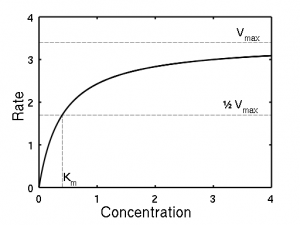 Here’s the all-grain formulation of Briggs-Haldane Barleywine. The wort for this barleywine is made by fully sparging the grain bed, and employing an extended boil to evaporate the excess water. You’ll need at least a 10-gallon (~40-L) kettle, but a 15-gallon (~60-L) kettle would be better. You only need about 7 gallons (26 L) of mash tun space, though. The long boil should darken the wort somewhat, and you can monitor how much color the boil develops, if you wish (see the options in the recipe). Remember that the long boil concentrates everything in the wort, not just the sugars. For that reason, don’t go overboard on mineral additions to your brewing liquor (water used to brew the beer with). Options for both continuous sparging and batch sparging are given.
Here’s the all-grain formulation of Briggs-Haldane Barleywine. The wort for this barleywine is made by fully sparging the grain bed, and employing an extended boil to evaporate the excess water. You’ll need at least a 10-gallon (~40-L) kettle, but a 15-gallon (~60-L) kettle would be better. You only need about 7 gallons (26 L) of mash tun space, though. The long boil should darken the wort somewhat, and you can monitor how much color the boil develops, if you wish (see the options in the recipe). Remember that the long boil concentrates everything in the wort, not just the sugars. For that reason, don’t go overboard on mineral additions to your brewing liquor (water used to brew the beer with). Options for both continuous sparging and batch sparging are given.
Don’t even think about not making the appropriately-sized yeast starter. This yeast strain will flocculate out early if underpitched, leaving a sticky-sweet mess of a beer. Pitched at the proper rate, it will ferment like a trooper.
Briggs-Haldane is an English-style barleywine with a complex malt character. It’s made with a blend of English pale ale malt and Munich malt, which gives it a rich, malty character. A little bit of wheat malt and a tiny amount of biscuit malt add some bready and cracker-like notes. The beer is not sweet, and it isn’t loaded with the strong caramel flavors found in some English barleywines. The beer is full-bodied, though, and this and the complex malt character is balanced by the hop bitterness (46 IBUs). The hop aroma is of “earthy” Fuggles hops. At 7.5% ABV, this is not the strongest English-style barleywine ever — but it really is flavorful and nicely balanced.
Briggs-Haldane Barleywine (Stovetop Extract Version)
Here is an English-style barleywine with a complex malt character. The blend of English 2-row pale ale malt with Munich malt gives this ale a rich, malty character. A little bit of wheat malt and a very small amount of biscuit malt add some bready and cracker-like notes. The beer is full-bodied, but not overly sweet — and with less caramel flavor than is found in some English barleywines. The complex malt character and body is balanced by the hop bitterness (46 IBUs) and the “earthy” character of Fuggles hops. This is not the strongest English-style barleywine ever, but it really is flavorful and nicely balanced. (It’s also delicious, in my opinion.)
The procedures were designed to work well for stovetop extract brewers. In order to do a full-strength, full-wort boil, the wort is made in two shifts. In each shift, the brewer uses roughly half the ingredients and yields 2.5 gallons (9.5 L) of wort. This helps with the hop utilization, but also allows for the small amount of wort darkening that a barleywine should undergo in the kettle. (If you can can boil a full wort, just brew this normally. Double the size of the yeast starter, though.)
Why I named this beer Briggs-Haldane Barleywine is not hard to derive, but I won’t bore you with the details.
Barleywine (IV: Attenuation and Malts)
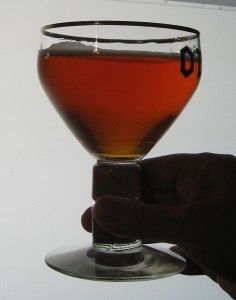
Barleywines are big, full-bodied beers. (This beer was a pale ale, but the color looks about right for a barleywine.)
Barleywines are full-bodied beers. Unlike double IPAs, which are also big, hoppy ales, the final gravity of a barleywine is usually in the 20s, when going by “gravity points” (SG 1.020–1.029). Sometimes it creeps up into the low 30s and others it drops into the high 10s. (The BJCP gives FG 1.018–1.030 for English barleywines and 1.016–1.030 for 1.016–1.030 for American barleywines.) For double IPAs, the brewer must make an effort to get the beer to finish under 1.020, or the hop character may be obscured.
Barleywine (III: Color)
 Recipes for barleywines can be very simple. Before exploring how to formulate a barleywine recipe, however, it pays to look at two things — color and attenuation. In this article, we’ll examine color.
Recipes for barleywines can be very simple. Before exploring how to formulate a barleywine recipe, however, it pays to look at two things — color and attenuation. In this article, we’ll examine color.
Color
Barleywines are, of course, strong ales. Their color varies from amber to copper, with a few English examples being in the brown range. The color of barleywine wort comes from three possible sources, caramelization during the boil, Maillard reactions during the boil and the concentration of colored molecules derived from the malt. (These molecules would be formed by Maillard reactions or caramelization during the malting process.)
Hero Barleywine (Extract Version)
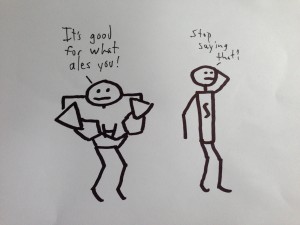 Here’s the extract version of Hero Barleywine, an American-style barleywine that is similar to Bigfoot. In order to brew the extract version successfully, you will need to do a few things. Firstly, and most importantly, you will need to make the yeast starter described in the recipe. Either that or use two 11-g sachets of dried yeast or three packs or tubes of liquid yeast. (You can get away with making a starter half this size, if necessary, but your fermentation will take longer to start.) Secondly, you need to be able to boil 3.5 gallons (13 L) of wort. So, you’ll need a 5-gallon (~20-L) brewpot and a good stove. If your stove’s output isn’t quite up to the task, you can use an immersion travel heater (the kind that lets you boil water to make tea in your hotel room) to help out. Plug it into a GFCI outlet. (If necessary, you can get away with boiling only 3 gallons (11 L), but your wort may end up a shade darker than it should be and the beer may not be as bitter.) Thirdly, for best results, you need to follow the directions here as closely as you can, given your equipment. Don’t just look at the ingredients and use your regular extract brewing techniques. There are a couple “odd” steps here, but they serve a purpose. And finally, use fresh liquid malt extract. This recipe was formulated based on the specs for Briess CBW Golden Light liquid malt extract (79% solids, 75% fermentability), but any light, reasonably fermentable made from US pale malts should work. Pilsner malt extract would also work. The most important thing that it be fresh. You can also use 8.25 lbs. (3.7 kg) of light dried malt extract, if fresh liquid malt extract is not available.
Here’s the extract version of Hero Barleywine, an American-style barleywine that is similar to Bigfoot. In order to brew the extract version successfully, you will need to do a few things. Firstly, and most importantly, you will need to make the yeast starter described in the recipe. Either that or use two 11-g sachets of dried yeast or three packs or tubes of liquid yeast. (You can get away with making a starter half this size, if necessary, but your fermentation will take longer to start.) Secondly, you need to be able to boil 3.5 gallons (13 L) of wort. So, you’ll need a 5-gallon (~20-L) brewpot and a good stove. If your stove’s output isn’t quite up to the task, you can use an immersion travel heater (the kind that lets you boil water to make tea in your hotel room) to help out. Plug it into a GFCI outlet. (If necessary, you can get away with boiling only 3 gallons (11 L), but your wort may end up a shade darker than it should be and the beer may not be as bitter.) Thirdly, for best results, you need to follow the directions here as closely as you can, given your equipment. Don’t just look at the ingredients and use your regular extract brewing techniques. There are a couple “odd” steps here, but they serve a purpose. And finally, use fresh liquid malt extract. This recipe was formulated based on the specs for Briess CBW Golden Light liquid malt extract (79% solids, 75% fermentability), but any light, reasonably fermentable made from US pale malts should work. Pilsner malt extract would also work. The most important thing that it be fresh. You can also use 8.25 lbs. (3.7 kg) of light dried malt extract, if fresh liquid malt extract is not available.

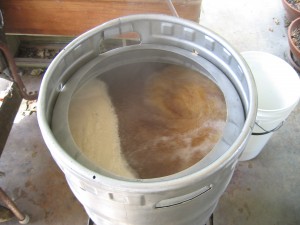
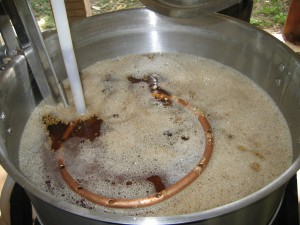

Recent Comments